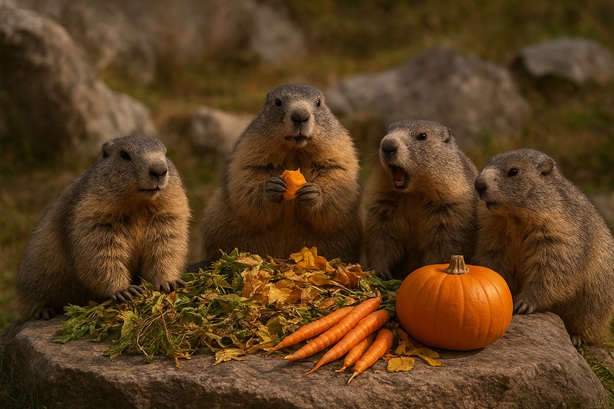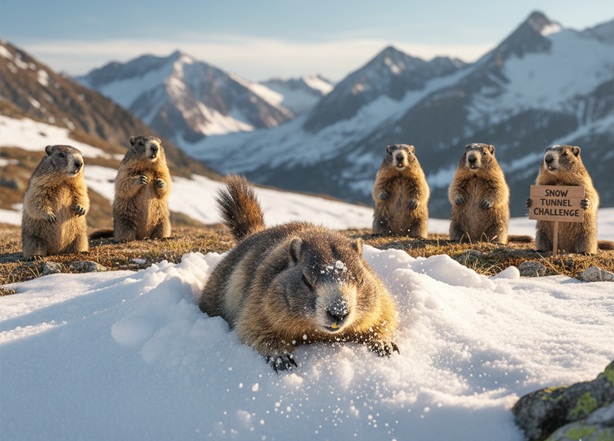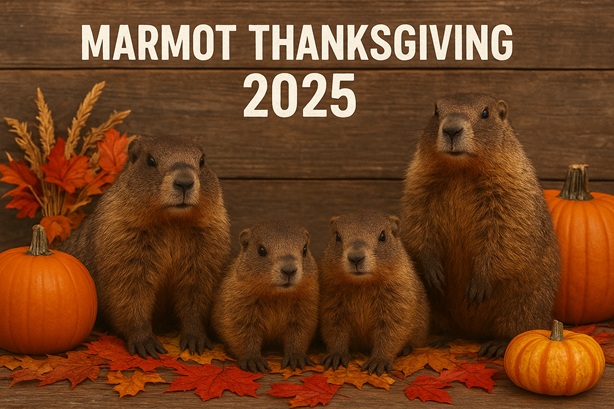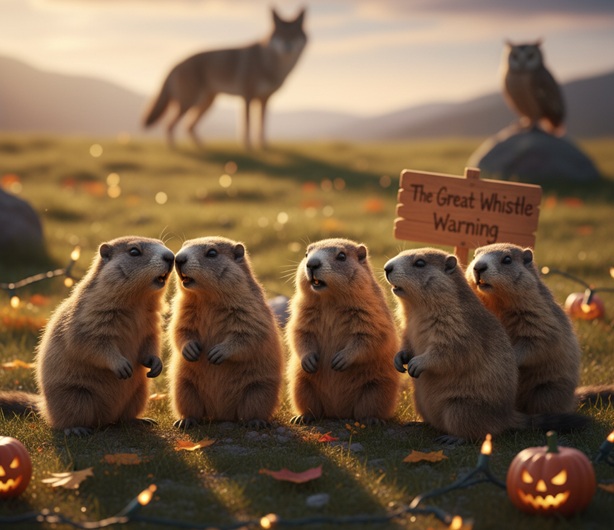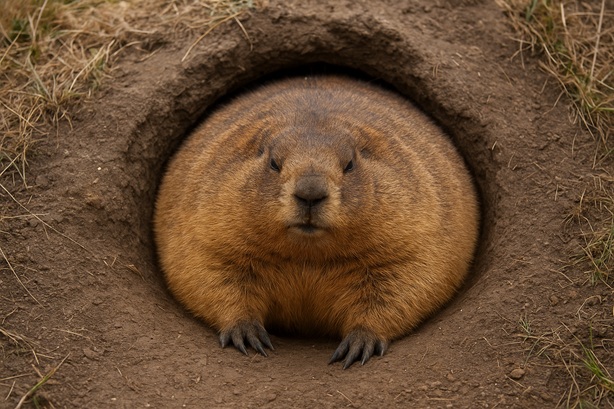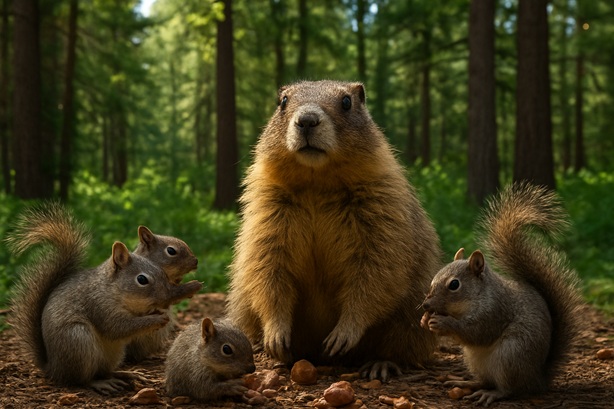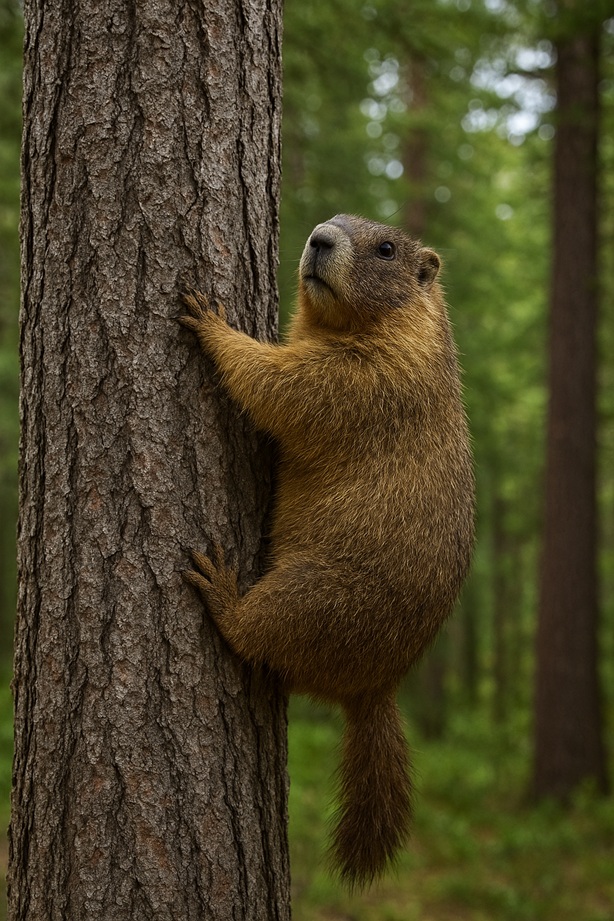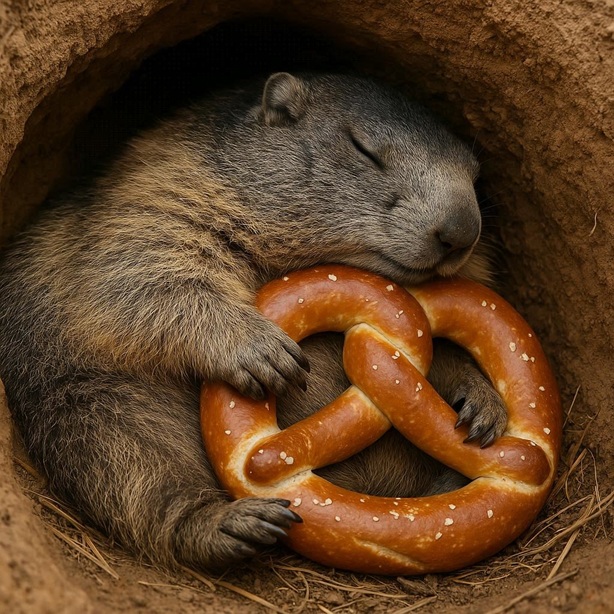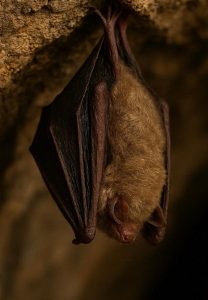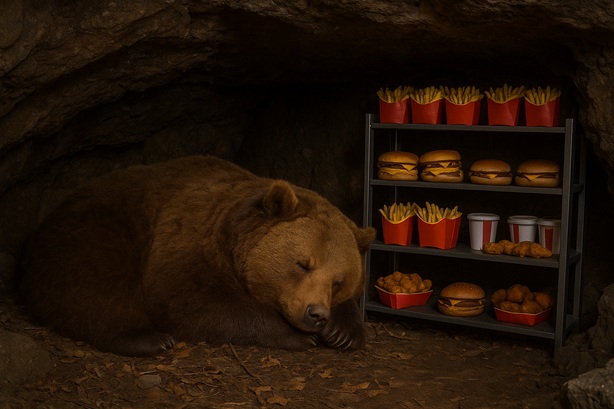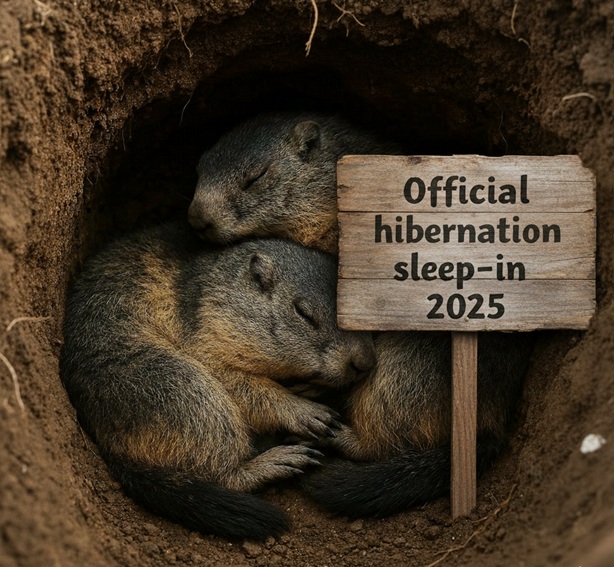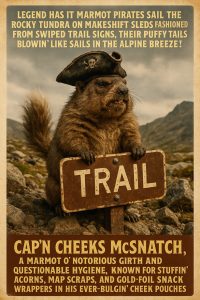Welcome to marmot Thanksgiving, the alpine holiday that’s 80% snack, 20% nap and 100% chaos.
For most of North America Thanksgiving means family, food comas and perhaps a highly questionable game of touch football. But for our beloved, rotund alpine rodents? It’s a day of blissful carb-induced oblivion, the culmination of a single-minded goal: achieve terminal rotundness before the snow flies.
Towards the end of fall, when things start to smell like winter (marmots claim it’s a very distinct smell), alpine marmots gather for their greatest culinary cultural tradition: the Marmot Thanksgiving.
Today, we delve into the hallowed (and heavily insulated) traditions of Marmot Thanksgiving, a celebration that makes your family’s turkey dinner look like an amateur’s effort.
The Feast of Many Leaves (and Even More Opinions)
 Marmots don’t roast birds. That’s just messy. Instead, they culminate their pre-hibernation binge with an extravagant, borderline irresponsible pile of nature’s finest roughage. Imagine an extravagant potluck of exactly what they found lying around, where fourteen cousins all bring the same dish of alpine grass, but make it wildly enthusiastic.
Marmots don’t roast birds. That’s just messy. Instead, they culminate their pre-hibernation binge with an extravagant, borderline irresponsible pile of nature’s finest roughage. Imagine an extravagant potluck of exactly what they found lying around, where fourteen cousins all bring the same dish of alpine grass, but make it wildly enthusiastic.
On the menu are wilted wildflowers (aged to perfection), crunchy dried grasses (the main course), dandelion fluff (the dessert of the season), the last surviving alpine grasses (with a little frostbite, due to the cold temperatures outside), “assorted greens” (translation: stuff that looked edible-ish) and that one weird root nobody likes (but Mossback McGrump never attends without).
As Cap’n Cheeks McSnatch, known for his ability to stuff a shocking volume of flora into his jowls, declared after a particularly vigorous session, “Arrr, it be a mighty salad bar indeed, but with the rowdy spirit o’ a full-contact brawl on the high alpine seas!” The traditional greeting? Always called out by Ol’ Whiskers, “May your greens be plentiful and your predators absent.” A warm greeting. A practical greeting. A greeting screamed at volume.
The Gratitude Whistle Ceremony (Guaranteed to Confuse at Least One Hawk)
Humans express gratitude around a table. Marmots, being masters of efficiency, use their infamous alarm whistle, as a chorus of emotional frequencies fills the valley.
“It’s a marvel of adaptive communication,” explains Dr. Helena Burrowtail, esteemed ethologist and author of the newly published The Social Lives of Subterranean Sleepers. “While ostensibly for predator warnings, during Thanksgiving, the pitch conveys specific sentiments.”
Each marmot takes a turn, letting out a whistle of varying pitch. Young Pip’s high whistle is “I survived a year without being eaten!” Ol’ Whiskers follows up with a medium whistle. “My burrow stayed dry!” Mossback McGrump’s low whistle adds, “My neighbor finally stopped borrowing my grass.” Nutmeg McChunky, whose whistle is famously shrill, blows his so loudly that a passing hawk does a mid-air U-turn, expecting a free lunch.
“Tradition!” shrugs Dr. Burrowtail, scribbling notes on a leaf. “It’s all about setting expectations.”
Cheeks McSnatch declares the ceremony a success. “Arrr, if a bird ain’t been properly baffled, it don’t be countin’, matey!”
The Post-Feast Mega Nap (Where They Drop, They Snooze)
Human Thanksgiving has the “food coma”. Marmots take it to the next level with the post-feast mega nap. It has a medical diagnosis code: instantaneous horizontal collapse syndrome (IHCS).
After stuffing themselves with forty metric tons of fiber, marmots simply fall over, wherever they are. Mid-sentence. Mid-whistle. Mid-chew. Entire families topple over like fluffy, grass-stuffed dominoes, massive fuzzy Jenga towers disintegrating onto the ground.
“It’s considered terribly impolite and extremely dangerous to nap on a slope,” cautions Dr. Burrowtail. “You might just roll all the way down to the pinyon forest and end up being raised by squirrels. Just ask Nutmeg McChunky.” Our beloved, bewildered Nutmeg, still occasionally seen trying to bury a particularly round pebble, nods sleepily from a very flat spot.
The Ritual Telling of The Great Snowstorm Story (Generally Accepted to be a Breezy Tuesday with a Few Flakes)
As bellies expand and eyelids droop, every colony has that one elder who insists on recounting the sagas of winters past. Ol’ Whiskers, now comfortably ensconced in a pile of napping youngsters, invariably begins: “Ah, The Blizzard of ‘87. Snow was forty feet deep. We tunneled through drifts for days. My whiskers froze solid. Young marmots today wouldn’t last ten minutes. The wind howled so loud, it knocked the grumble right out of Mossback McGrump!” Mossback lets out a low, offended growl in his sleep. Eyewitness accuracy is not Ol’ Whiskers’ strong suit. He embellishes the story a little more every year.
Master Squeak Windwhisker whispered to the youngsters, “He says that every year. One time he said the snow was sentient.”
Still, young marmots listen respectfully, feigning awe. Older marmots, like the ever-skeptical Cap’n Cheeks, roll their eyes so hard they almost fall out. Everyone pretends this is a valuable cultural lesson, not just a prelude to deep sleep.
The Great Pre-Hibernation Swap (“Brown Friday”)
Instead of Black Friday, marmots have Brown Friday, the last big frantic rearranging of food piles. It’s less about consumerism and more about competitive bartering.
Trades include soft roots for crunchy stems (Pip is always seeking crunch), flower heads for seed clusters (Master Squeak Windwhisker is surprisingly picky about his seed-to-fluff ratio) and occasionally, a particularly smooth pebble, offered as an item “of emotional value”.
The undisputed master of the barter economy is Cap’n Cheeks McSnatch, who once traded a single pinecone for three roots, half a dandelion puff and Nutmeg McChunky’s temporarily respect.
“Nobody keeps accurate track,” explains Dr. Burrowtail. “Everyone believes they got the better deal. It’s the marmot version of a win-win, as long as you’re too sleepy to count.”
The Great Colony Yawn: Party Over. Wrap it Up.
When the feast is done and the final root is hoarded, the entire “meal” culminates with the ultimate synchronized, colony-wide yawn. It’s deeply symbolic, a collective sigh of contentment and surrender.
Forty marmots inhale. Forty marmots exhale. Forty marmots create a harmonized gust of warm, grassy breath. Sometimes just gassy.
This signals that the feast is done, the naps shall begin, winter is coming and please, please stop eating. There is no more room inside anyone. The Thanksgiving Marathon has officially ended and the long, glorious slumber can begin.
Dr. Burrowtail notes, “This synchronized yawn is both symbolic and deeply biological. Also, it smells like fermented kale.”
Final Thoughts
Marmot Thanksgiving is part feast, part family chaos, part pre-hibernation carb party, part competitive gratitude ceremony and mostly a very fluffy countdown to winter sleep.
Honestly? Between the lack of awkward family questions and the mandatory six-month nap, it might just be better than the human version.
So this Marmot Thanksgiving, whether you’re participating in a competitive gratitude whistle, bartering roots on Brown Friday or collapsing into an IHCS-induced food coma, remember this: Somewhere, Nutmeg McChunky is still trying to bury a pebble, the hawk is still confused and Ol’ Whiskers is still insisting the snow was forty feet deep and mildly intelligent. And truly, that’s what the holiday is all about.
May your holiday be equally legendary and equally exaggerated. Happy Thanksgiving, everyone! May your bellies be full, your burrows be warm and your dreams be full of dandelion fluff!

